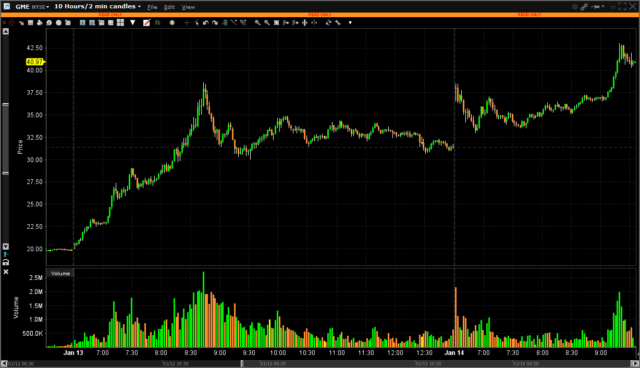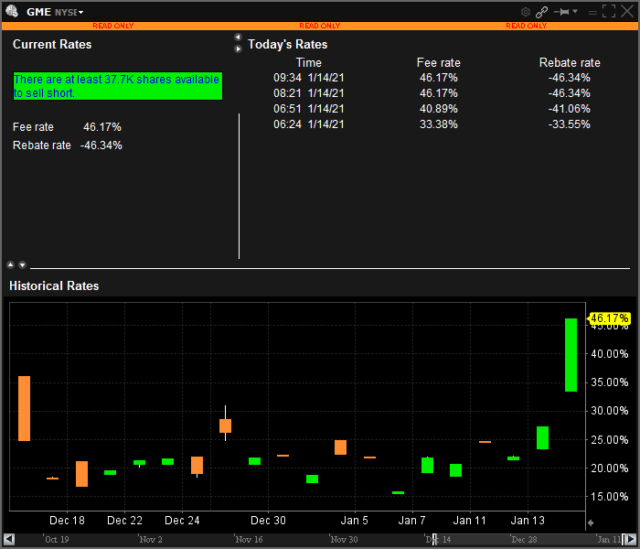It’s been a good run up in the market in the past month. Just last month I thought I was headed for the first negative quarter since Covid hit. Now it’s a race for the finish in the last two weeks of September.
There’s been a component in my portfolio (you can guess which one it is, I’ve written about it before) that almost has GME-like properties at the moment, albeit the business model is slightly more viable and I think the hype cycle is around the 3rd inning of this particular baseball game.
One always needs to ask themselves when enough is enough.
The trading mechanics of stocks nearing a mania high is punctuated by intense volatility both on the upside and downside.
Gamestop is a perfect illustration of this.
You had a few trading days (look at late January) where it ranged from $200 to $450 in what could be classified as insanity.
Even a week before that, when it spiked from $40 to $100, that was considered insanity.
Nobody wants to be the person selling GME at $40 on its way up to $400, but you had to wait four trading days (not to mention a weekend) to make this happen. Retrospect makes for 20/20 vision, but doing this in the heat of the moment is a hugely difficult endeavour.
What’s funnier is if you set your limit order at $300, psychologically you would have still felt ripped off since you had the potential for another 50% gain ($450)… “If only I set the limit sell price at $400 instead of $300 that day”.
That said, share dispositions do not have to be a binary decision – you can choose to trim tiny amounts as prices rise. This is my personal approach to things, although logically it doesn’t make sense.
Overall, however, we are seeing a commodity-driven boom. There is a lot of forward expectation and you can see this with the single digit P/Es projected in most of these companies.
ARCH, for instance, is trading at 6 times projected 2021 earnings. Coking coal is going crazy and Arch is down 4% today. What gives?
My Divestor Oil and Gas index has Q2 guidance below current spot prices and even with that guidance, companies are trading at EV/(free cash flow) levels of the high single digits (and if you ignore debt leverage, the price to cash flow ratio is even lower). Natural gas is spiking – you’re seeing Henry Hub gas prices this winter heading north of US$5/mmBtu, and AECO is north of CAD$4 and it’s still September.
It’s a really difficult decision to be selling equities that are trading at single digit multiples of cash flows when prevailing investing options for near-safe money is so terrible. You can’t even go to the debenture or preferred share markets, which are more or less a wasteland in my humblest of opinions.
Still, I sold a small holding of Western Forest (TSX: WEF) earlier this year, when they were on track to earn about a quarter of their market capitalization in 2021.
Embedded in each of these companies is an implied bet on the future of specific commodities (met coal, gas, oil or otherwise). There is also an embedded skepticism that current prices will remain in each of the share prices. It could entirely be the case that the market is assigning a gigantic discount to future cash flows for whatever reason. If this is the case then buying and waiting for the returns to flow in is logical. Inevitably, it will happen – the most conservative approach companies make is paying down their debt, and then after that, they will have the choice of raising dividends or buying back stock.
This is unless if the real economy crashes and takes the commodity market with it. Then, those single-digit P/Es will rise very quickly.
As for the title of this post, I do not know. As much as it makes mathematical sense, margin investing always makes me nervous. The proper time to do it is when you are feeling absolutely sick in the stomach to buy and right now it just makes too much damn sense to borrow at 1.5% and buy these single digit P/E stocks. This is why I’m not doing it and am slowly raising cash instead, because the decision to increase zero-yield cash in my portfolio hurts the most. It won’t be an extreme move – just enough to make me a little more comfortable.


